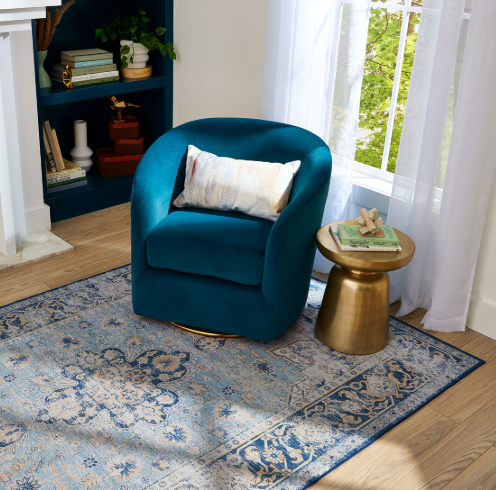Rugs can add comfort and style to your home, but they can also be a source of frustration when they start sliding across the floor. Did you know that nearly 38,000 adults over 65 are treated annually for falls caused by rugs? It’s essential to keep your rugs in place, not just for aesthetic reasons but for safety as well. Let’s explore how to prevent rugs from slipping and keep your home safe and stylish.
What Causes Rugs to Slip?
Before we dive into how to stop your rug from moving, it’s important to understand the common reasons behind rug slippage:
- Floor Type: Smooth surfaces like hardwood, tile, and laminate offer little grip, making it easier for rugs to slide. The lack of friction between the rug and the floor often causes unwanted movement.
- Rug Material and Type: Rugs made from synthetic fibers or those with smooth backings tend to slip more easily, especially on hard floors. A rug with no non-slip backing is more likely to move around.
- Traffic and Use: Areas with heavy foot traffic, such as hallways and living rooms, see the most rug movement. Pets, kids, and even vacuuming can contribute to your rug sliding.
- Lack of Anchoring: A rug without proper anchoring—like a rug pad or furniture to weigh it down—can easily shift out of place.
- Weight and Size of the Rug: Lighter, smaller rugs are more prone to sliding, while larger, heavier rugs tend to stay put better.
- Environmental Factors: Humidity or temperature changes can affect both the floor and the rug materials, causing slipping, especially in moisture-prone areas like bathrooms.
Now that we know the reasons behind rug movement, let’s explore practical ways to prevent it and keep your space safe.
How to Keep Rugs in Place on Different Floors
Every floor type requires a unique solution to prevent your rug from sliding. Here’s how to handle it based on the flooring in your home.
- Hardwood Floors:
Hardwood floors may look beautiful, but they provide little grip for rugs. To keep your rug in place, invest in a high-quality non-slip rug pad or rug grippers. These tools will provide the necessary traction to prevent movement without damaging your floors.
- Carpeted Floors:
Layering rugs on top of carpet requires specific attention. Use Velcro strips or rug anchors designed for carpeted surfaces to prevent sliding without harming the underlying carpet fibers.
- Tile and Laminate Floors:
For tile or laminate floors, smooth surfaces can make rug stability a challenge. Use double-sided rug tape or gripper tape for a temporary fix, or opt for rubber rug pads for a longer-lasting solution.
Practical Solutions to Keep Rugs from Sliding
Here are a few effective solutions to ensure your rug stays in place:
- Non-Slip Rug Pads and Grippers:
A non-slip rug pad is essential for stability. It not only cushions your rug but also prevents it from sliding on any surface. For extra security, you can use rug grippers—small adhesive or non-adhesive attachments that secure the corners of your rug.
- Double-Sided Tape:
In a pinch, double-sided carpet tape can be used to anchor smaller rugs. While this is a temporary solution, it works well for rugs in high-traffic areas. Be careful, as the tape may leave residue on some floor finishes.
- Silicone Caulking:
For a DIY option, you can apply silicone caulking to the underside of your rug. Once dry, it will create a grip that prevents the rug from slipping. Just make sure to test it on a small area of the rug first to ensure it doesn’t cause any damage.
- Anchor Rugs with Furniture:
One of the simplest ways to keep your rug in place is by strategically placing heavy furniture on top of it. A coffee table or sofa can anchor larger rugs, adding both functionality and style to your space without needing extra materials.
By taking the right precautions and using these simple solutions, you can stop your rugs from sliding and create a safer, more inviting space. Whether you’re working with hardwood floors, carpet, or tile, these tips will help keep your rugs secure and your home stylish.
